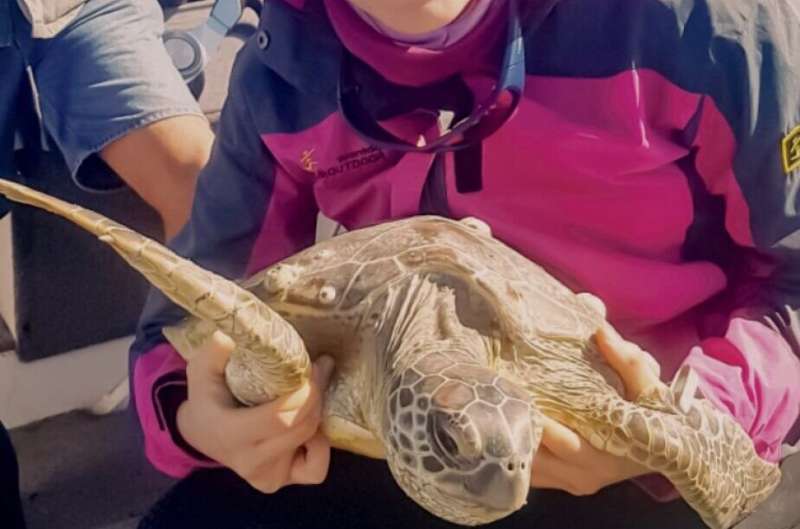This article has been reviewed according to Science X's editorial process and policies. Editors have highlighted the following attributes while ensuring the content's credibility:
fact-checked
peer-reviewed publication
proofread
New way to check if turtles are 'fat and happy'

A groundbreaking technique developed by a JCU researcher could revolutionize how we measure the health of sea turtles and other threatened species.
In two recently published papers as part of her Ph.D., JCU researcher and veterinarian Dr. Sara Kophamel documented how she adapted a device known for measuring body fat in humans (bioelectrical impedance analysis or BIA) to measure the body fat of green sea turtles examined across several locations around the Great Barrier Reef. The studies were published in Ecology and Evolution and Physiological and Biochemical Zoology.
Dr. Kophamel's Ph.D. supervisor, ecophysiologist and biomedicine researcher Associate Professor Suzy Munns, said high fat content in turtles is considered healthy for the animals.
"Increased fat enables breeding and an increased ability to survive changes in their environment, such as a cyclone destroying sea grass beds, so it gives them a buffer," Associate Prof Munns said.
"Our hope is to ultimately improve the chances of survival for these turtles, which means we need to understand the animal and the threats it faces."
Dr. Kophamel said the tool will be a valuable aid for turtle researchers worldwide, adding to the existing range of methods already in use.
"What many biologists and ecologists do is look at how much a turtle weighs and measure their shell, and based on that, they make an assessment of the turtle's health," she said.
"But these measurements are a very poor surrogate for determining turtle health. It's like using the Body Mass Index in humans. It can give you some indications as to whether you are underweight or overweight, but there might be certain physiological conditions that you can't account for.
"So, essentially we needed another method to assess the nutritional status of turtles."
Turtles were examined for their body fat content using BIA, before being taken to a radiology clinic where they underwent Computed Tomography (CT) scans.
"We then identified and quantified the body fat from the CT scans by training a complex artificial intelligence (AI) model with the help of JCU Senior Lecturer Dr. Dmitry Konovalov, which ended up automating this process," Dr. Kophamel said.
"The CT scans were used for reference to make sure that the BIA device was estimating body fat accurately with the AI algorithm."
With the accuracy of Dr. Kophamel's device now verified and field tested, Associate Prof Munns said the research could also act as a basis for analyzing the health of other threatened species.
"We have developed the tool, but also the roadmap which will shortcut the process for other researchers wanting to use this technique to assess the health of other species," she said.
More information: Sara Kophamel et al, Field‐based adipose tissue quantification in sea turtles using bioelectrical impedance spectroscopy validated with CT scans and deep learning, Ecology and Evolution (2022). DOI: 10.1002/ece3.9610
Sara Kophamel et al, A Standardized Protocol for Measuring Bioelectrical Impedance in Green Turtles (Chelonia mydas), Physiological and Biochemical Zoology (2022). DOI: 10.1086/722451
Journal information: Physiological and Biochemical Zoology , Ecology and Evolution
Provided by John Cook University


















